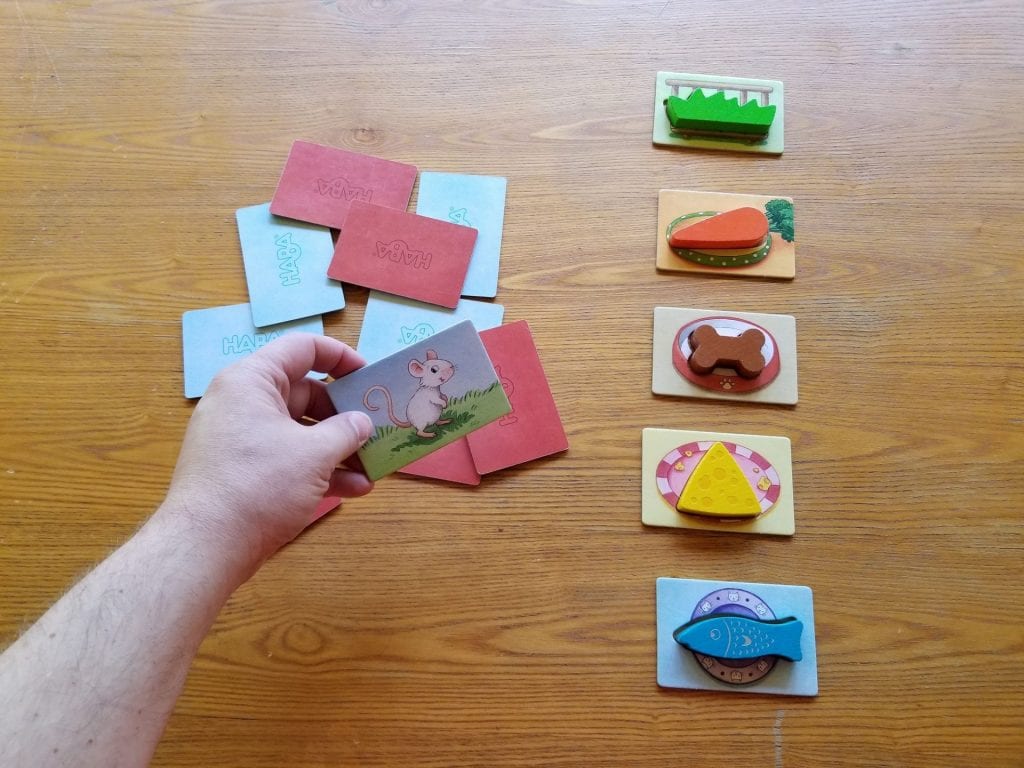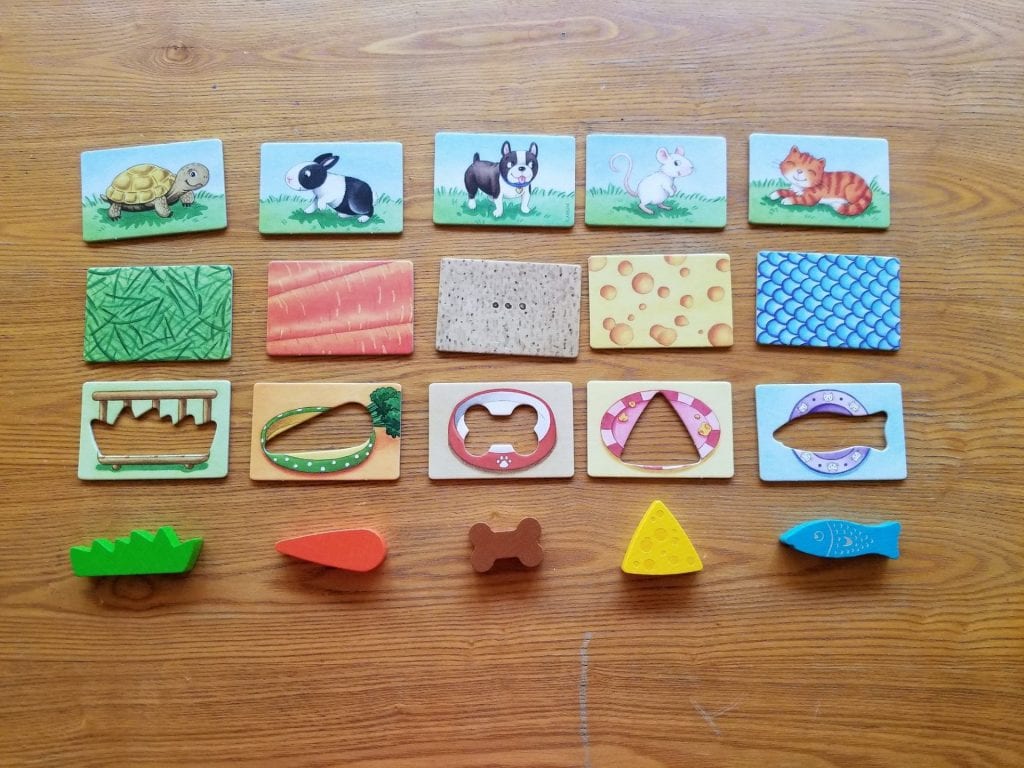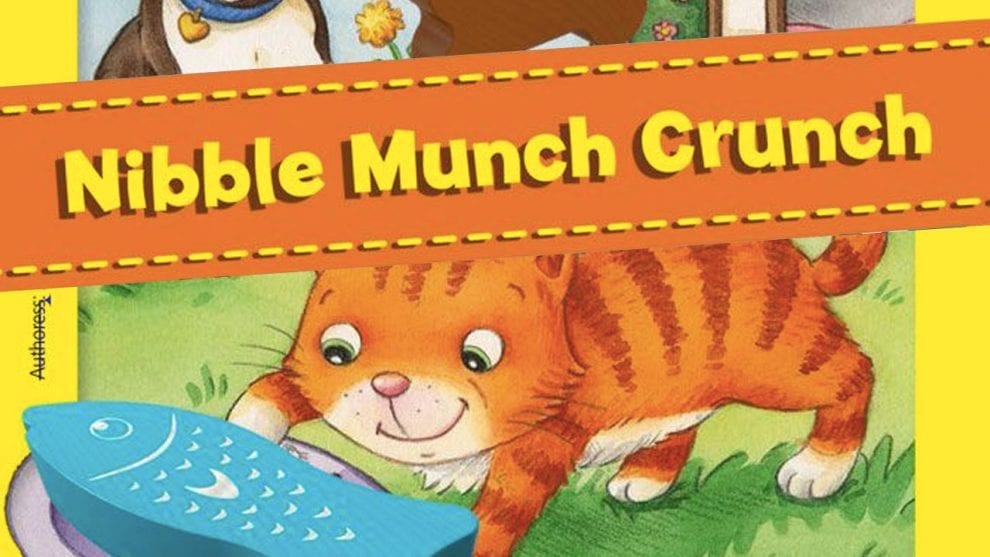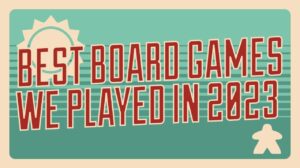Disclosure: Meeple Mountain received a free copy of this product in exchange for an honest, unbiased review. This review is not intended to be an endorsement.
Where does the carrot go? What does the mouse eat? For that matter, which animal is the dog even?
Nibble Munch Crunch, part of HABA’s My Very First Games series, puts your child in charge of pairing up various animals — a Boston terrier pup, a cuddly orange tabby cat, a curious bunny rabbit, a methodical turtle, and a cheeky little mouse – with their favorite meals. Composed of a handful of 15 tiles and several chunky wooden blocks shaped like different colored foods, Nibble Munch Crunch includes 3 different modes of play – Free Play, What Do Animals Eat?, and Who Eats What? – that will challenge your child’s grasp of colors, shapes, and knowledge of animals.
Free Play
In Free Play mode, you and your child can spend time exploring the game components together. Which tile features the picture of the bunny? Which tile does the wooden fish fit into? Show me the yellow tile. There’s no real objective here other than to appreciate, manipulate, and learn about the game materials and their various features.
Skills For Life: Sometimes being observant and exploring the components spread out before you in great detail is tantamount to success. If your child masters these skills, you can look forward to games like Wish You Were Here in your future – an intense, thrilling mystery game contained on several postcards stuffed into an envelope. Don’t let its small size fool you, though. It’s a very challenging puzzle.
What Do Animals Eat?
To set up for this mode, first place the animal tiles face down into a stack. Then set out all of the other tiles face up – the 5 cut-out cards and the 5 color cards – along with the wooden food blocks.

Now, flip over an animal tile. What’s this animal called? A correct answer should be met with praise. Wrong answer? No big deal. Just tell them the correct one. It’s all part of the learning process.
Next question: what does this animal eat? Find the matching wooden piece and then fit it into the matching cut-out tile. There’s only 1 tile it will fit into correctly, so even if they get it wrong the first time, they’ll eventually get there in the end.
Alright, here’s another quiz for you: what color is the wooden piece? Once you and your child have determined the color of the wooden piece, match it up with the correct color tile and place the cut-out and wooden block on top of it. Once again, with only 5 options, it won’t take you long to get there.
Now feed that poor animal. Push the entire stack of cut-out, wooden block, and color tile to the matching animal to get it fed. Onwards to the next hungry critter!
Skills For Life: Being able to intake information from one component and dexterously match it up with another one is a useful skill that will serve your child well in games like Cobra Paw when they’re older, a frenzied tile-grabbing game where you’re challenged to be the first to grab the domino-style tile matching the icons rolled on the game’s two dice.
Who Eats What?
So your child’s a regular Einstein and has mastered the other two modes. What now? Look no further than ‘Who Eats What?’, a memory tile-matching game.
To begin, each player is given one of the wooden food blocks and places it into the matching cut-out tile. Then the remaining tiles are placed face down onto the table in a random array. You can even swish them around to make sure they’re good and mixed up if you feel so inclined. As a matter of fact, go ahead and do that. Or better yet, let your child do it! Disregard the title on the box. The name of the game here is FUN!

Once everything is good and shuffled, the players take turns flipping over one of the face down tiles. What do you see on the card? Once they’ve answered correctly, it’s time to determine whether the revealed tile matches up with the food on the player’s tile. Does the cat match up with the plate of cheese? Is the blue tile the same color as the bone? If there’s a match, then the tile is collected. If there isn’t a match, the revealed tile is flipped back over and it’s the next player’s turn.
Then you just keep going until every player has a matching set of food, cut-outs, animal, and color cards. In the game of feeding adorable animals, everyone wins.
Skills For Life: There are a lot of games that challenge you to hang onto the information you’ve gained through trial and error. Mastering this ability to retain hidden knowledge is a skill that will serve your child well when you and they are eventually able to play Hanabi together. It’s a cooperative card game of hidden information that challenges you to give clues to the other players and use the clues you’ve been given to create a fireworks display before you run out of time.
Thoughts
As an avid board gamer who is also a parent, I dream of the day that I am able to sit across the table from my son for a soothing session of Fields of Arle or a cutthroat game of Twilight Struggle. But he’s only 2, so I am painfully aware that those days of heavy gaming are far, far into my future. That is why games like the titles in the My Very First Games series delight me. They give me the opportunity to share the hobby that I love with the little guy that I love in a way that he loves. Bright, colorful, chunky components pair with educational and engaging gameplay that puts a smile on both of our faces.

My son can’t get enough of Nibble Munch Crunch. He’s become rather adept at slotting the wooden pieces into their matching cut-outs and I must confess that I feel like a proud papa seeing him do it without making even a single mistake. We’ve progressed to the second mode of play, too. We enjoy talking about the different animals and what they like to eat and while he can’t pronounce the various colors yet, he seems to recognize them when he’s tasked with finding them most of the time. Matching the animals with their favorite foods is a task at which he excels, but only when directed who to deliver the food to. So far he doesn’t understand questions like: “Which animal likes the bone?” But he definitely understands: “Give the bone to the dog.” It’s interesting and exciting to watch him get better and better at the game and I think that’s what keeps me engaged as a parent. Because, let’s face it, this is a game I am mostly playing for my son.
As for the third mode of play, we’re not quite ready for that yet but I look forward to the day that we are. For now, I’ll take what I can get and when it comes to playing board games with my son, I can’t get enough.
For some other great games you can play with younger children, check out our Top 6 Games to Play With Younger Kids.












Add Comment